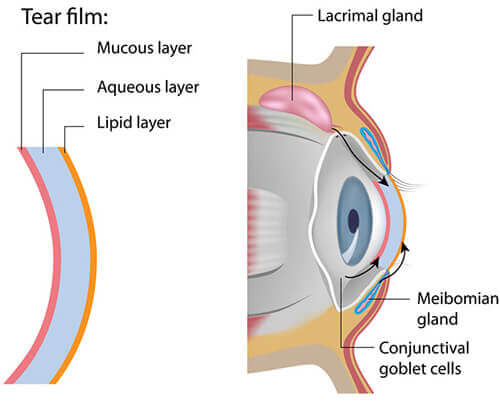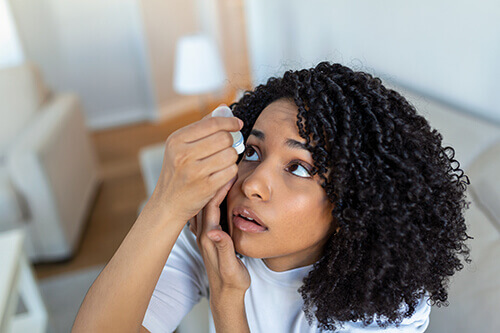Effective Dry Eye Treatment
What is Dry Eye?
Normally, the eye constantly bathes itself in tears. By producing tears at a slow and steady rate, the eye stays moist and comfortable. Sometimes people don’t produce the right quality or quantity of tears to keep their eyes healthy and comfortable. This condition is known as dry eye.
Symptoms of Dry Eye
Stinging, burning, a scratchy or gritty feeling, strings of mucus in or around your eyes, pain when wearing contacts or, oddly enough, watery or excessive tearing are all symptoms of dry eyes.
How Tears Work

Your eyes produce and need tears to stay moist and healthy. When a person blinks, a film of tears is spread over the surface of the eye. This tear film consists of three layers: each layer has a special purpose.
An oily layer (Lipid) made in the Meibomian glands is the outside layer and keeps our tears from drying or evaporating too quickly.
A watery layer (Aqueous) produced by the lacrimal glands in the eyelids is the middle layer of tear film. This watery layer is what we commonly call tears and cleans and washes the eye.
The mucus layer (Mucous) helps to stick the watery layer or tears to the surface of the eye, in turn, keeping the eye moist. It is the innermost layer of the tear film. The conjunctiva or clear tissue that the covers the white of the eye and inside the eyelids produces the mucus.
The eye uses two speeds of production to produce tears. Either at a slow, steady rate to maintain normal eye lubrication or if irritated, or, for instance, we cry, at a much faster rate of production. Watery eyes, are a result of the eyes attempting to produce enough tears to correct the irritation that is disrupting the normal steady rate and therefore, a symptom of a dry eyes.
Causes of Dry Eye
There are many causes of dry eye. As we age, hormonal changes cause us to make fewer tears. This is more common in women who are post-menopause but can affect men as well. Diseases, certain medications, contact lenses, refractive surgery, long periods of reduced blinking while at the computer, dry, windy climates and other eye conditions can all contribute to dry eyes. Our ophthalmologist will want to know about all prescription and non-prescription you take and will do a thorough exam before deciding on your treatment plan.
Treatment Plan for Dry Eye

Depending on the cause and severity of your dry eye condition and after a thorough discussion with your ophthalmologist a treatment plan will be developed. This generally falls into the following categories:
- Increasing Tears – You may be given a prescription for eye drops that aid in tear production
- Adding Tears – Artificial tears may be recommended which can be purchased over the counter.
- Saving Tears – Punctal Plugs may be recommended to block your tear ducts enabling your natural tears to remain in and on the eye longer. These plugs can be removed later as needed or surgery may be recommended to permanently close your tear ducts.
Our physicians at Ophthalmology Associates are highly trained in all aspects of dry eye disease and can provide the best available treatment. Call for your appointment today!
